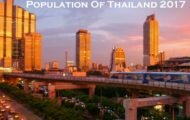Gyeonggi-do is the most crowded area in South Korea. The capital of the province is Suwon. Seoul is the biggest city however it has been independently controlled as a provincial level city since the year 1946. The Province has been an imperative critical territory since 18 BCE, when Korea was partitioned into three countries amid the Three Kingdoms time frame. The geography of the province is separated into southern and northern zones by the Han River, which streams from the east side to the west. Since Seoul comes under the province of Gyeonggi, it has benefitted a lot with a large number of tourist visiting the province and adding a lot to its economy. The province is one of the most visited in South Korea and additionally there are a large number of attractions as well as sites to see. Tourists from China, Japan and other countries visit here to check out some of the interesting places within the province. The province is very famous for its Korean food.

POPULATION OF GYEONGGI IN 2017:
Talking about population, in order to check out the population of Gyeonggi in 2017, we need to have a look at the population of the past 5 years. They are as per the following:
- 2012 – 11.4 Million
- 2013 – 11.8 Million
- 2014 – 12.34 Million
- 2015 – 12.7 Million
- 2016 – 12.98 Million
Getting from the past data of Gyeonggi from the year 2012-16, it has been noticed that there has been an increase of 1.58 Million in the past 5 years. Therefore, it has been seen that every year the population increases by 0.316 Million. Hence, the population of Gyeonggi in 2017 is estimated to be 12.98 Million + 0.316 Million = 13.296 Million. So, the population of Gyeonggi in the year 2017 as per estimated data = 13.296 Million.
GYEONGGI Population 2017 – 13.296 Million(Estimated)
DEMOGRAPHY OF GYEONGGI:
As indicated by the evaluation of 2005, 34% follow after Christianity and 17% are into Buddhism. 51.1% of its population is generally not religious or believe in Islam. In the year 2010, there were around 4,527,282 families, having an average of 3 individuals for every family. The province consisted of about 6,112,339 males and 5,959,545 females.
POPULATION DENSITY AND GROWTH OF GYEONGGI:
The population density of Gyeonggi is 1170 persons per square kilometer. The Province has seen a fast increment in population because of the urbanization and modernization of South Korea. Its populace has expanded from 2,748,765 in the year 1960 to about 12,071,884 in the year 2010.
The population growth of Gyeonggi has been of a moderate pace in the recent years and it is expected that its population will grow at a faster rate in the coming years.
FACTS ABOUT GYEONGGI:
- The geography of Gyeonggi is partitioned into south and north regions by the Han stream, which goes from east side to the west. The north side to the River is chiefly rocky, while the southern region is for the most part plain.
- Gyeonggi is uniformly developed in heavy industry and that includes: Electronics, chemical industry, machine etc. Because of the impact of late high wages, the heaviness of manufacturing enterprises has diminished in the economy of Korea.
- Sailing is a prominent sport in the province. Its area on the bank of the waterway Han makes it a perfect scene for the game which is host to the prestigious Korea Match Cup event. The occasion draws the world’s best teams to the province to in a dramatic clash of nerve and ability on the water. The indistinguishable provided boats are hustled two at a time which tests the skippers and sailors.
- After the establishment of two Korean governments, the Province and also its capital, Seoul, were isolated with partial locales of the province being fused into Seoul from that point. Moreover, Kaesong turned out to be North Korean domain, the main city to change control after the nations were partitioned at the 38th parallel, which is presently part of North Hwanghae Province in North Korea.
- In the year 1967, the seat of the Gyeonggi government was exchanged to Suwon from Seoul. After Incheon isolated from Gyeonggi in the year 1981.



